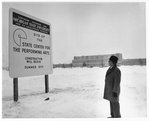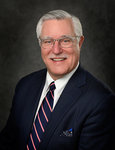




Eric Olmscheid has a strange sense of timing when it comes to taking a new job. He started work as the fourth executive director in the 40-year history of MSU’s Wharton Center for Performing Arts June 22.
Olmscheid takes the reins after an unprecedented pandemic that shuttered the facility for 18 months and, in the words of his predecessor, Michael Brand, “re-defined an act of God.”
Before coming to Wharton, he served 14 years as programming director of Des Moines Performing Arts, where he took over in the wake of the nation’s worst recession in decades.
Olmscheid is good at keeping the lights on, sometimes literally. He ran a gymnasium light board for his high school’s production of “Damn Yankees.”
Through brutal cycles of recession and inflation, a global pandemic and ongoing challenges to live arts venues from movies, TV, home theaters and whatever comes next, he remains convinced the arts will always be essential to human life.
“Some of our first gatherings were for arts events,” he philosophized. “People came together for outdoor concerts, with painted circles in the grass, or songs and trumpeters in the streets. The arts will continue to gather people together.”
But the show doesn’t go on by itself. While overseeing day-to-day operations at the region’s largest performing arts center, Olmscheid is charged with retooling it for an uncertain future. Among his top priorities are attracting a younger and more diverse audience, including students, expanding education programs and linking up with a developing cadre of new arts leaders at MSU to build a broader arts strategy.
“Organizations like the Wharton Center, and all over the country, persevered,” Olmscheid said. “They figured out how to remain relevant during the pandemic shutdown and, more important, they asked themselves: Who are we? What are we doing as we emerge into the next chapter?”
Juggling act
James Forger, dean of the MSU College of Music and chairman of the search committee that recommended Olmscheid, called the top job at Wharton “quite a juggling act.”
“You need to be self-sufficient, generate a big budget through Broadway, raise supplemental dough from donors, grow the educational programs,” Forger said. “You have the logistics of being home to the Lansing Symphony. And then,” he added, with a guilty chuckle, “it’s also home to certain groups that don’t create revenue, meaning the College of Music and its large ensembles.”
Olmscheid compared the Wharton Center’s mix of programs to an ecosystem, with blockbusters like “Wicked” helping to “underwrite the shows that may not do as well at the box office, or, frankly, require significant subsidy even just to be on our stage.”
He isn’t crazy about the showbiz formula that “rock pays for Bach,” but he admitted, “it’s kind of true.”
“And we have to have that mix, as a major university presenter and a robust, diversified performing arts center,” he said.
To further complicate the job, he has to make many commitments a year or more in advance while keeping an eye on national macroeconomic curves, broader cultural trends and other arcane tea leaves.
“All of our operational expenses, our labor costs have all increased,” Olmscheid said. “We’ve pushed the price of the arts experience to the point where it’s not achievable for some. We have to balance the equation, but it doesn’t always add up.”
The pandemic “significantly drained” Wharton’s reserve funds, Olmscheid said, but federal aid, mostly via the Shuttered Venue Operators Grant, helped replenish them.
“Now we are back on a solid financial footing, able to take risks and move forward,” he said.
Lessons from Iowa
Olmscheid made his mark at the Wharton Center long before he was chosen as its director. MSU Provost Judith Stoddart, a key leader in the current consolidation of the university’s arts institutions, said the search committee was deeply impressed with his work in Des Moines.
In 2016, Olmscheid received the Broadway League Award for outstanding achievement in engagement. The educational programs he developed in Des Moines grew to reach 75,000 patrons a year, according to Broadway World Detroit.
The Wharton Center is a well-established hub for an interlocking set of programs linking hundreds of Michigan students with lessons and workshops from Broadway pros, from K-12 to grad school.
“These programs are already familiar here, but that’s in part because we learned a lot from Des Moines,” Stoddart said.
“What stood out about Eric was his commitment to education and audience engagement, and the fact that he’s been recognized nationally for that.”
Olmscheid shook things up onstage as well. He led a fresh wave of arts programming in Des Moines, notably Live at the Temple, a small-venue “listening room” concert series.
“He’s interested in connecting specific audiences with the kinds of art forms they’d like to see, asking what we’ve offered in the past and whose voices and perspectives are missing,” Stoddart said.
Wharton’s 2022-’23 season was already set when Olmscheid arrived, but he said he’s “proud to inherit” it from Brand, and he’s working with his team to shape the 2023-24 season “and whatever we add to the current year.”
This fall’s schedule at the Temple is a preview of the kind of acts Olmscheid will bring to Wharton — a genre-blurring rainbow of human faces and musical styles, from Arkansas bluesman Larry McCray to Louisiana Cajun band BeauSoleil, Latin rock singer Gina Chavez, jazz singer Shayna Steele, alt-country singer-composer Amy Helm and composer/vocalist Somi, a champion of African music with deep roots in Rwanda and Uganda. There isn’t a single white male headliner in sight — no gel-haired Broadway crossover bros, no stern gray eminences.
Olmscheid also launched a dance and a family series in Des Moines. He’s particularly proud of the Iowa High School Musical Theater Awards, a statewide, year-long program involving 90 schools.
“It was a significant investment in arts education across the entire state,” he said.
At Wharton, Olmscheid hopes to replicate a program he developed with the Des Moines Parks Department to organize over 50 free performances in public spaces during the pandemic summers of 2020-’21 and 2021-’22.
The concerts began as a response to a crisis, but they effectively broke the walls between the performing arts center and the community.
“That’s something we can look at as a model here for the Wharton Center as well,” he said.
Farm to soundboard
Olmscheid, 41, grew up on a dairy farm in central Minnesota, as did his predecessor at the Wharton Center, Michael Brand. The nearest town was tiny Saint Martin (population 308 in 2010). Farming was not his thing. His brother took over the family farm; he took a pass.
“I didn’t think of it like this at the time, but the arts were like my refuge way from that,” he recalled.
Singing in a church choir and a youth chorus gave him his first taste of the performing arts. In ninth grade, he saw his first professional Broadway touring show — a revival of “Showboat” at the Orpheum Theater in Minneapolis.
Hunched in the back row of the balcony, with his head pressed against the wall, he watched Cloris Leachman take a curtain call.
“I thought, ‘I don’t know what this is, but I want to do this,’” he said. He did everything remotely arty in high school — band, choir, one-act plays, yearbook.
In fall 1994, he was asked to run the lights of a high school production of “Damn Yankees.”
Needless to say, it wasn’t a state-of-the-art digital lightbox. “I was running the lights out of a breaker box,” he recalled. “I was captivated by this idea of telling a story, creating a fantasy in an old high school gym and cafeteria. That was the moment where I thought, ‘Wow, this could really be something.’”
Later that year, he was spellbound by a production of “A Christmas Carol” at the Guthrie Theatre in Minneapolis.
“I could walk you through the theater and still point to the seat where I sat,” he said. “It was so important to me, so powerful.”
He set out to become an arts teacher, but felt confined in the classroom. The arts dean at the University of Minnesota Duluth, where Olmscheid studied as an undergraduate, recognized his love of the arts and community-mindedness and suggested he add business acumen to the mix.
Olmscheid realized that arts administration, an arcane field he had never considered, would enable him to harmonize art and business on a large scale and make a difference in a community.
He finished his music degree but promptly “took a left turn” to study arts and culture management at Saint Mary’s University of Minnesota.
“That allowed me to focus on the business side of show business,” he said. “It’s equally show and business, and if we don’t understand both, the equilibrium will be off-balance.”
While studying at St. Mary’s, he worked his way through half a dozen jobs at the Ordway Center for the Performing Arts, marking another convergence with his predecessor.
Brand started as an intern at the Ordway in 1986, the year it was formed, and helped build it into a premier national venue as director of programming and marketing before moving on to Wharton in 2003.
Down from the pedestal
Venues like the Wharton Center are having limited success in drawing younger audiences, but the market for live performing arts is still aging. Market researchers have a spectacular euphemism for it: “negative substitution of the historic visitor.”
The pandemic blew a hole in that slowly sinking boat. Attendance at American performing arts events in 2021 plunged to a devastating 54.5% of 2019, according to the arts research firm IMPACTS Experience.
In January 2022, the same firm found that arts venues had the market potential to bounce back to 85.9 percent of 2019 attendance, but the pandemic scrambled the picture so thoroughly it may take years for venues to refocus.
Olmscheid said it would be a “long endeavor” to build back to pre-pandemic attendance “as our event habits have, expectedly, shifted.”
“Many of our guests have found different priorities or just slowed down a bit,” he said. “If you used to go to four to six arts and cultural events a month, you might only be going to two to three. We’re trying to figure out what a new normal is.”
Fortunately, performing artists are more eager than ever to get off their pedestal and find new audiences.
“We used to have to beg artists to do the lowest-hanging fruit, like a master class,” Olmscheid said. “Now they’re much more open to that. Artists see it as a way of connecting, staying relevant, breaking down this barrier of ‘I don’t leave the stage.’”
The era when someone like Mad Magazine’s Eric von Schteric, “the world’s loudest tuba player,” swaggers into town, plays a concert and climbs back into his limo is long gone.
“We have to be more intentional about inviting people in,” Stoddart said, “but also think about how we take the arts outside, present in other spaces, engage in formal and informal ways.”
In the next few years, Olmscheid and the College of Music want to offer more public appearances and concerts outside traditional venues like Fairchild Theatre and the Wharton Center.
“How can we bring visiting artists, some of the best talent, out — unannounced, without selling tickets, in a lobby or a campus building?” Forger said.
Damien Sneed, a writer-composer-musician whose skills range from hip-hop to gospel, classical music, jazz and beyond, did a range of outreach events on his visit to the Wharton Center Dec. 21 to perform with Brandie Sutton for a program honoring Martin Luther King Jr.
Even Renee Fleming, arguably the foremost opera diva in the world, dug in for a grueling round of master classes as part of her October 2018 Wharton appearance.
“I remember her sitting in my office, asking me what outreach we do,” Forger said. “She wasn’t killing time. She’s the opposite of a prima donna. She was fascinated by projects like the Community Music School in Detroit.”
Many performing arts centers, including the Wharton Center, are specifying some form of local engagement, from impromptu free public performances to master classes, as a contract item.
“It becomes part of the agreement on the front end,” Olmscheid said. “If that’s not part of what you’re interested in doing, then we’ll have to decide if that’s going to meet our goals.”
A November 2019 residency by the Imani Winds, a charismatic, multi-racial, polystylistic wind quintet from New York, included a week of master classes, outside appearances, and a formal concert at the Wharton.
The ensemble will return to Wharton for another residency in May of 2022 and premiere a new work by Sneed.
When it comes to growing and greening the audience, another arrow in Olm-scheid quiver is the new wave of Broadway shows that deal forthrightly with a range of burning social topics and showcase under-represented realms of experience.
A perfect example is Detroit-born playwright, composer and lyricist Michael R. Jackson’s “A Strange Loop,” the chronicle of the author’s experience as a Black, gay and large man. It won the 2022 Tony Award for Best Musical.
“I had a chance to see ‘Strange Loop’ recently in New York,” Olmscheid said. “It’s Michael R. Jackson’s lived experience, showcased beautifully onstage. ‘Kite Runner’ is another example.”
Playwright Matthew Spangler’s adaptation of Khaled Hoseeini’s “The Kite Runner,” set in Afghanistan’s turbulent recent history, came to Broadway in 2022.
“They’re both real stories we’ve always said we wanted, stories of the moment and of the time, but the Broadway community has really embraced,” Olmscheid said.
Nearly 30 years ago, “Showboat,” with its head-on depiction of racial inequality and prejudice, awakened Olmscheid to issues of class and race that didn’t penetrate his corner of rural central Minnesota.
“The story had never been told in a way that was reachable for me,” Olmscheid said.
Although the flaws, stereotypes and white-centeredness of “Showboat” have been dissected in umpteen revivals, autopsies and re-revivals, the empathy for others embedded in the show’s DNA leads directly to the breakthrough shows that refreshed Broadway in the 2010s.
To Olmscheid, there’s no need to choose between escapist fantasy and social engagement.
“As a theater-goer, I want both,” he said. “I want the sense of joy, the buoyancy, the escape from the world for a moment. But I also want to be challenged. I want my empathy to be built for someone else’s existence who is not my own.”
Support City Pulse - Donate Today!
Comments
No comments on this item Please log in to comment by clicking here